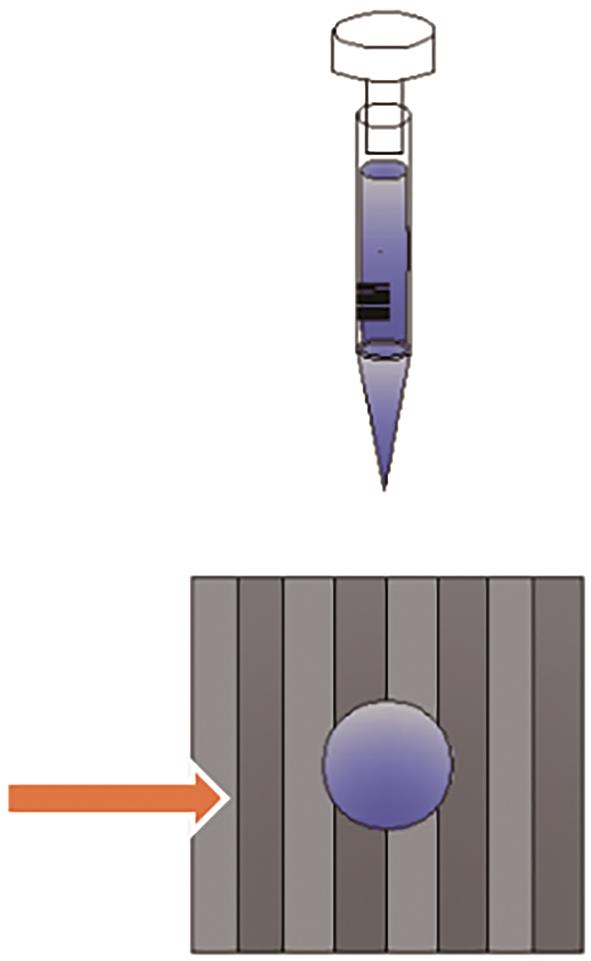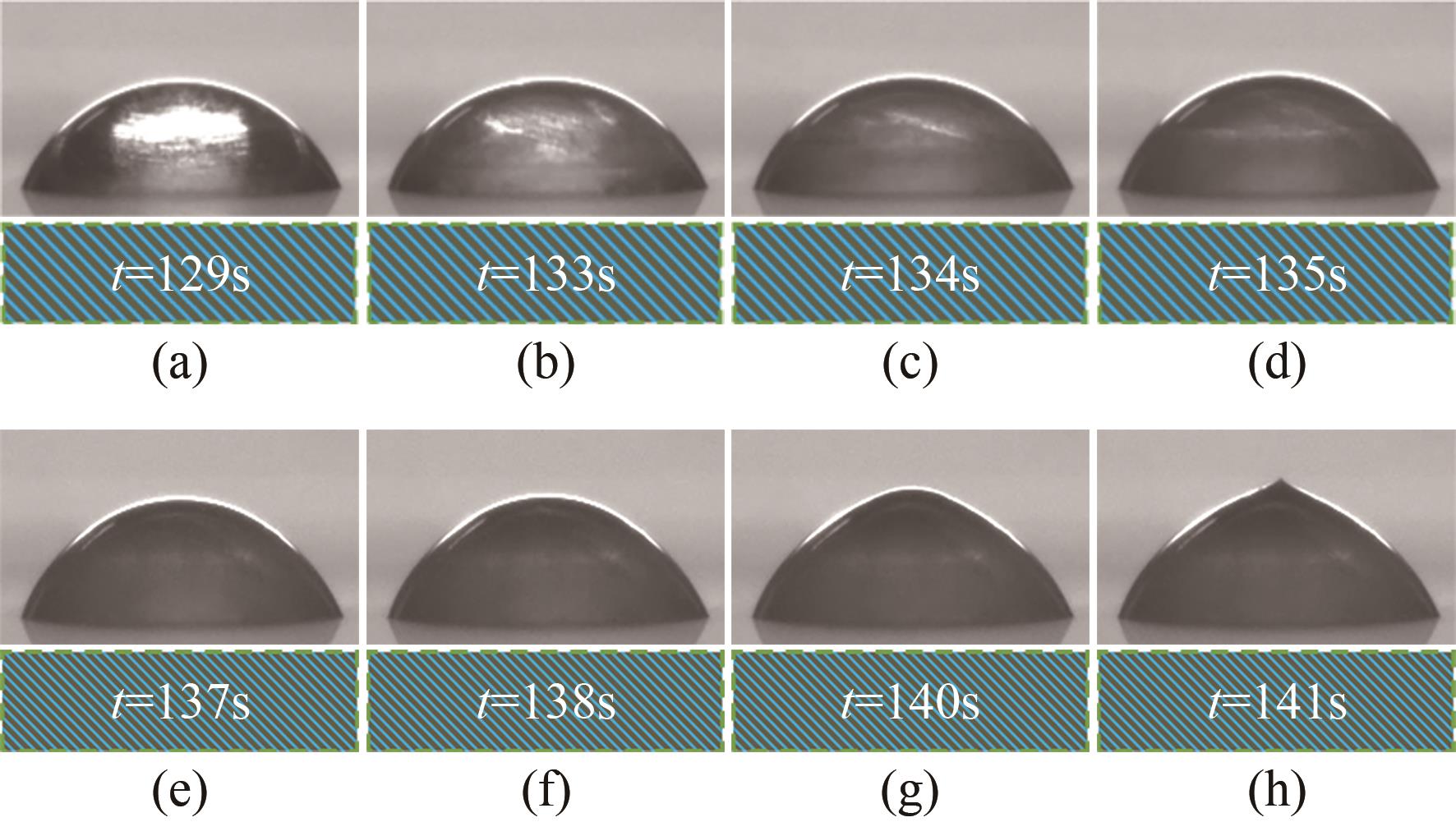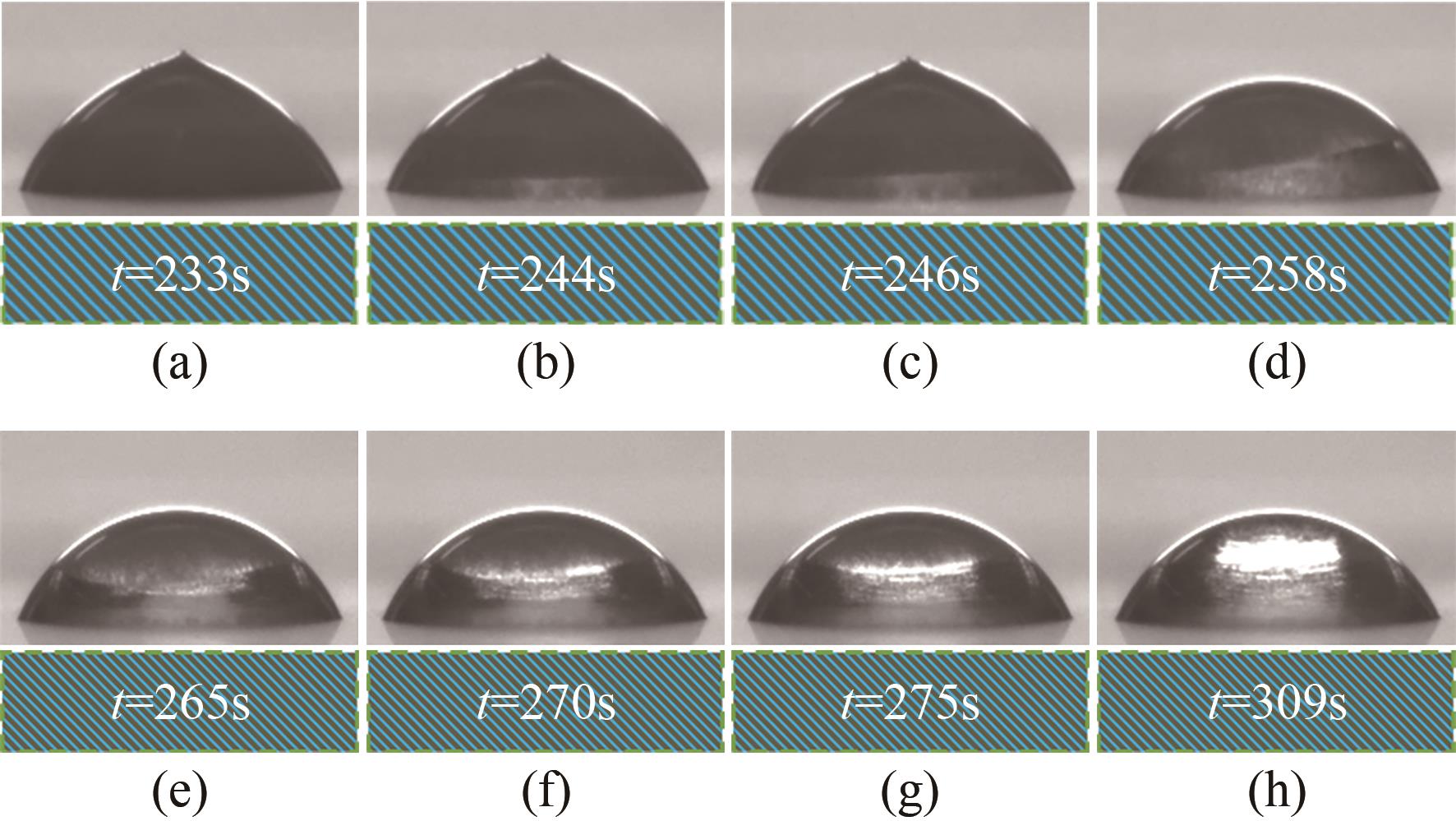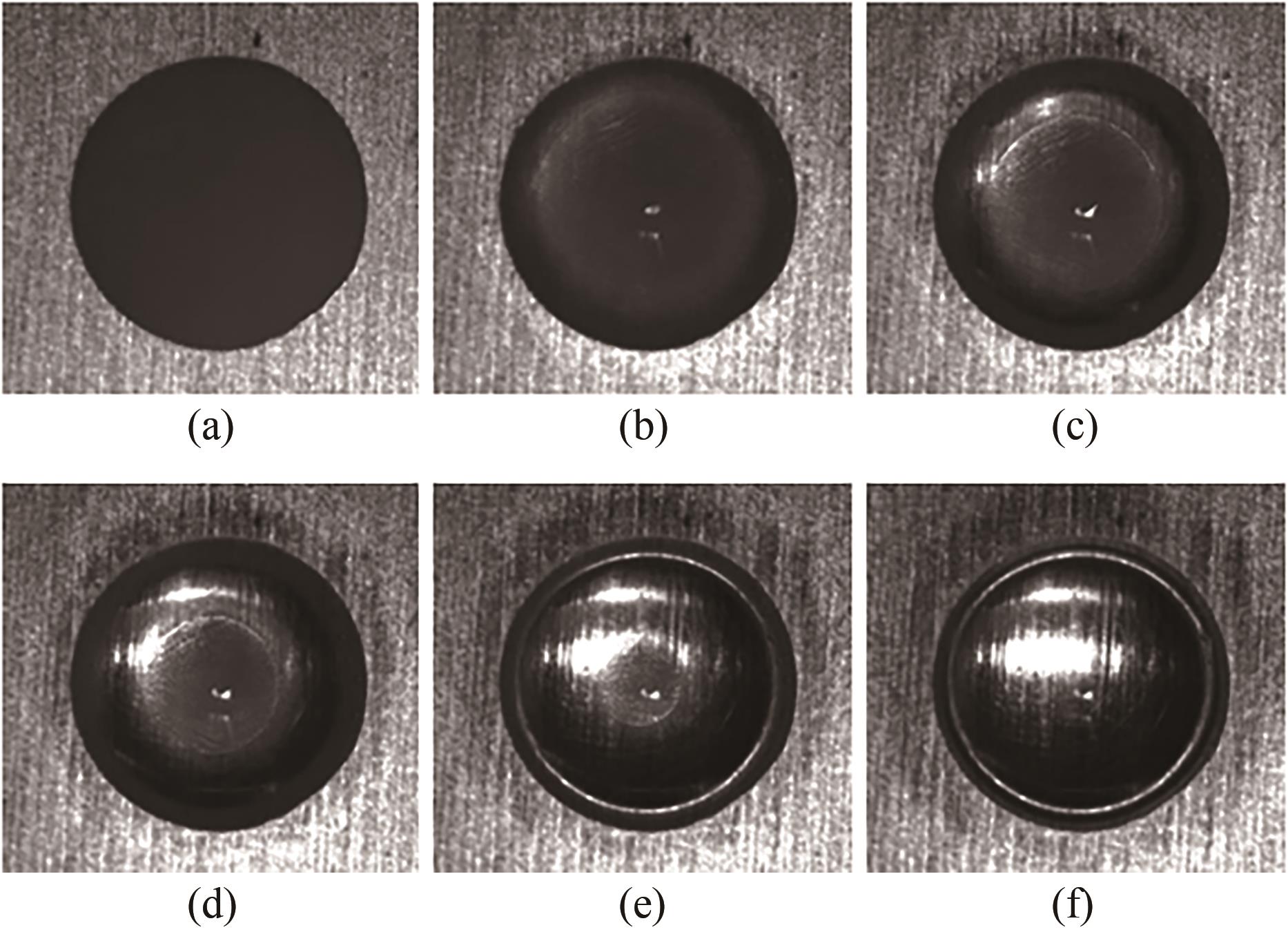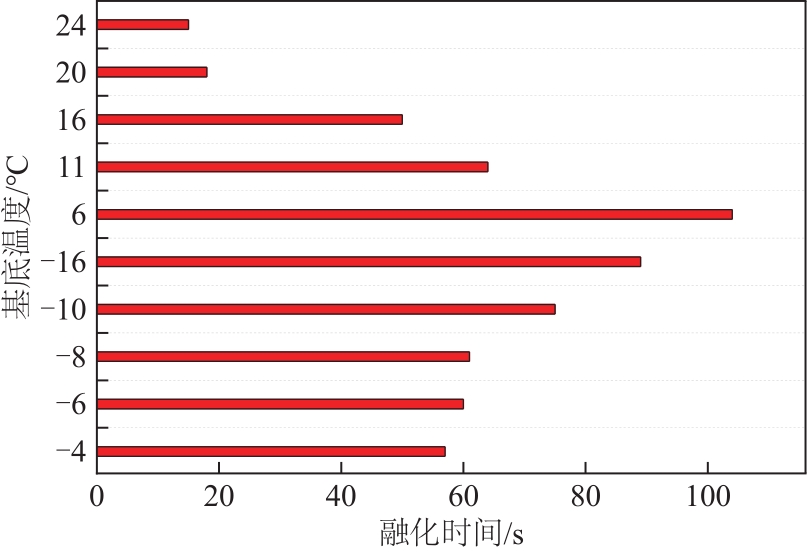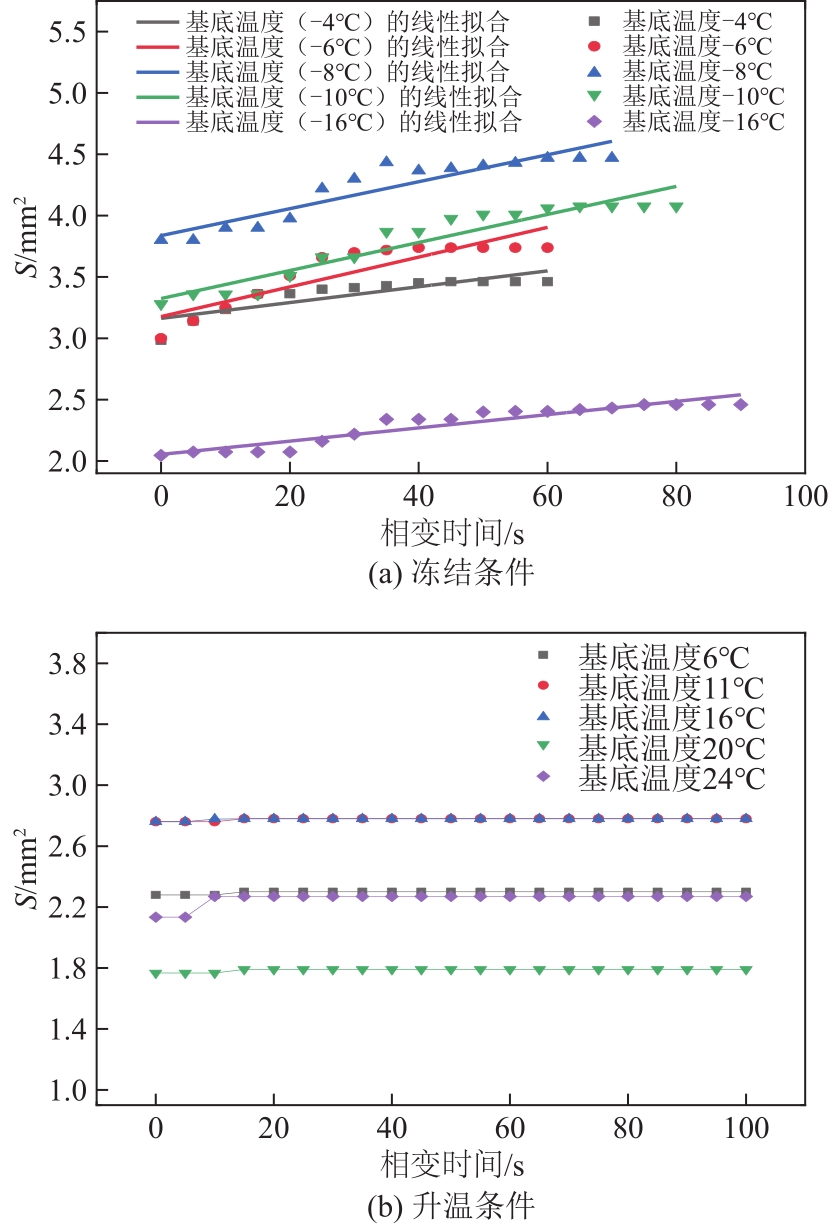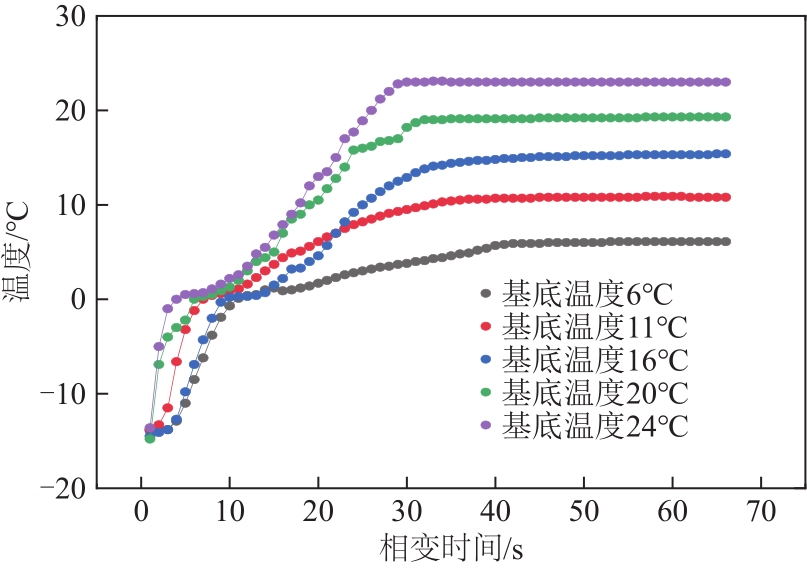化工进展 ›› 2022, Vol. 41 ›› Issue (9): 4605-4617.DOI: 10.16085/j.issn.1000-6613.2021-2277
固体表面温度对冻结液滴的相变过程与表面润湿特性的影响
张哲( ), 郎元路, 陈佳楠, 吴巧燕, 计宏伟, 李星泊, 马妍, 陶柳倩, 王瑾悦
), 郎元路, 陈佳楠, 吴巧燕, 计宏伟, 李星泊, 马妍, 陶柳倩, 王瑾悦
- 天津商业大学天津市制冷技术重点实验室,天津 300134
-
收稿日期:2021-11-08修回日期:2022-02-09出版日期:2022-09-25发布日期:2022-09-27 -
通讯作者:张哲 -
作者简介:张哲(1975—),男,博士,教授,硕士生导师,研究方向为换热器强化换热。E-mail:zhangzhe@tjcu.edu.cn。 -
基金资助:国家自然科学基金(12172254);天津市自然科学基金(21YDTPJC00300);天津市研究生科研创新项目(2020YJSS066);天津商业大学大学生创新训练项目(202110069171)
Analysis of effect of solid surface temperature on phase transition process and surface wetting characteristics of frozen droplets
ZHANG Zhe( ), LANG Yuanlu, CHEN Jia’nan, WU Qiaoyan, JI Hongwei, LI Xingbo, MA Yan, TAO Liuqian, WANG Jinyue
), LANG Yuanlu, CHEN Jia’nan, WU Qiaoyan, JI Hongwei, LI Xingbo, MA Yan, TAO Liuqian, WANG Jinyue
- Tianjin Key Laboratory of Refrigeration Technology, Tianjin University of Commerce, Tianjin 300134, China
-
Received:2021-11-08Revised:2022-02-09Online:2022-09-25Published:2022-09-27 -
Contact:ZHANG Zhe
摘要:
通过液滴可视化实验,发现并归纳了冻结液滴在不同基底温度下于铝板表面融化过程的动态表面润湿特性,结合力学分析,总结了液滴润湿面积、体积、接触角等润湿参数与相变时间之间的变化规律。实验结果表明:液滴的润湿性主要受重力、表面张力、热毛细力的影响,重力对液滴的横向扩散促进作用、表面张力与热毛细力受底板温度影响具有抑制液滴润湿过程的作用;两种不同条件下,冻结液滴高度变化规律相同,随着融化的进行,液滴高度骤降,然后缓慢降低;不同冻结条件下,冻结液滴的润湿过程主要发生在融化初始阶段,重力促进液滴的润湿过程,液滴接触角处于65°~85°之间,而在润湿后阶段,接触角减小,重力的作用减弱,表面张力的作用增强,液滴的扩散进程受阻,体积下降的趋势也变缓;不同升温条件下,冻结液滴的润湿过程几乎没有发生,热毛细力与表面张力在润湿过程中占据主导性,随着基底温度的升高,液滴内部与三相线温差逐渐增大,Ma数呈增加的趋势,数值由1802增至22876,热毛细力始终抑制液滴的运动。
中图分类号:
引用本文
张哲, 郎元路, 陈佳楠, 吴巧燕, 计宏伟, 李星泊, 马妍, 陶柳倩, 王瑾悦. 固体表面温度对冻结液滴的相变过程与表面润湿特性的影响[J]. 化工进展, 2022, 41(9): 4605-4617.
ZHANG Zhe, LANG Yuanlu, CHEN Jia’nan, WU Qiaoyan, JI Hongwei, LI Xingbo, MA Yan, TAO Liuqian, WANG Jinyue. Analysis of effect of solid surface temperature on phase transition process and surface wetting characteristics of frozen droplets[J]. Chemical Industry and Engineering Progress, 2022, 41(9): 4605-4617.
| 组件名称 | 参数名称 | 参数值及名称 |
|---|---|---|
| 摄像头 | 型号 | Allied Vision Stingray F-046B |
| 精度/μm | 8.3 | |
| 最大帧率/帧·s-1 | 61 | |
| 变焦倍率 | 6.5 | |
| 传感器型号 | Sony ICX415 | |
| 接触角精度/(°) | 0.3 | |
| 接触角分辨率/(°) | 0.01 | |
| 光源 | 型号 | 单色LED照明 |
| 观测舱 | 规格 | 150mm×150mm×60mm |
表1 DSA-30液滴形状观测实验台组件及相关参数
| 组件名称 | 参数名称 | 参数值及名称 |
|---|---|---|
| 摄像头 | 型号 | Allied Vision Stingray F-046B |
| 精度/μm | 8.3 | |
| 最大帧率/帧·s-1 | 61 | |
| 变焦倍率 | 6.5 | |
| 传感器型号 | Sony ICX415 | |
| 接触角精度/(°) | 0.3 | |
| 接触角分辨率/(°) | 0.01 | |
| 光源 | 型号 | 单色LED照明 |
| 观测舱 | 规格 | 150mm×150mm×60mm |
| 基底温度/℃ | σ/mN∙m-1 |
|---|---|
| 6 | 74.78 |
| 11 | 74.07 |
| 16 | 73.34 |
| 20 | 72.75 |
| 24 | 72.59 |
表2 去离子水的表面张力
| 基底温度/℃ | σ/mN∙m-1 |
|---|---|
| 6 | 74.78 |
| 11 | 74.07 |
| 16 | 73.34 |
| 20 | 72.75 |
| 24 | 72.59 |
| 参数 | 6℃ | 11℃ | 16℃ | 20℃ | 24℃ | |||
|---|---|---|---|---|---|---|---|---|
| ρ/g∙cm-3 | 1 | |||||||
| cp /kJ∙kg-1∙℃-1 | 4.186 | |||||||
| k/W∙cm-3 | 0.548 | 0.582 | 0.592 | 0.60 | 0.608 | |||
| μ/10-3 N∙s∙m-2 | 1.4728 | 1.2713 | 1.1111 | 1.0050 | 0.9142 | |||
表4 去离子水的热物性参数
| 参数 | 6℃ | 11℃ | 16℃ | 20℃ | 24℃ | |||
|---|---|---|---|---|---|---|---|---|
| ρ/g∙cm-3 | 1 | |||||||
| cp /kJ∙kg-1∙℃-1 | 4.186 | |||||||
| k/W∙cm-3 | 0.548 | 0.582 | 0.592 | 0.60 | 0.608 | |||
| μ/10-3 N∙s∙m-2 | 1.4728 | 1.2713 | 1.1111 | 1.0050 | 0.9142 | |||
| 1 | ROISMAN I V, BREITENBACH J, TROPEA C. Thermal atomisation of a liquid drop after impact onto a hot substrate[J]. Journal of Fluid Mechanics, 2018, 842: 87-101. |
| 2 | DING Y, JIA L, ZHANG Y X, et al. Investigation on R141b convective condensation in microchannel with low surface energy coating and hierarchical nanostructures surface[J]. Applied Thermal Engineering, 2019, 155: 480-488. |
| 3 | LEONI A, MONDOT M, DURIER F, et al. Frost formation and development on flat plate: experimental investigation and comparison to predictive methods[J]. Experimental Thermal and Fluid Science, 2017, 88: 220-233. |
| 4 | CHENG C H, SHIU C C. Frost formation and frost crystal growth on a cold plate in atmospheric air flow[J]. International Journal of Heat and Mass Transfer, 2002, 45(21): 4289-4303. |
| 5 | NISHIMOTO S, BHUSHAN B. Bioinspired self-cleaning surfaces with super-hydrophobicity, superoleophobicity, and superhydrophilicity[J]. RSC Advances, 2013, 3(3): 671-690. |
| 6 | JIANG L, ZHAO Y, ZHAI J. A lotus-leaf-like superhydrophobic surface: a porous microsphere/nanofiber composite film prepared by electrohydrodynamics[J]. Angewandte Chemie International Edition, 2004, 43(33): 4338-4341. |
| 7 | WANG H, WANG D T, ZHANG X Y, et al. Modified PDMS with inserted hydrophilic particles for water harvesting[J]. Composites Science and Technology, 2021, 213: 108954. |
| 8 | HOU Y Q, WANG Q X, WANG S L, et al. Hydrophilic carbon nanotube membrane enhanced interfacial evaporation for desalination[J]. Chinese Chemical Letters, 2022, 33(4): 4. |
| 9 | KIM T H, CHANG SONG K. Effect of types of hydrophilic acrylic monomers in reducing glistenings of hydrophobic acrylic intraocular lenses[J]. Optical Materials, 2021, 119: 111401. |
| 10 | WANG J T, XU R Z, YANG F, et al. Probing influences of support layer on the morphology of polyamide selective layer of thin film composite membrane[J]. Journal of Membrane Science, 2018, 556: 374-383. |
| 11 | ZHAO D L, ZHAO Q P, CHUNG T S. Fabrication of defect-free thin-film nanocomposite (TFN) membranes for reverse osmosis desalination[J]. Desalination, 2021, 516: 115230. |
| 12 | XU H, KUCZYNSKA M, SCHAFET N, et al. Modeling the anisotropic temperature-dependent viscoplastic deformation behavior of short fiber reinforced thermoplastics[J]. Composites Science and Technology, 2021, 213: 108958. |
| 13 | ZHU C Z, PENG L, YU J J, et al. A numerical study on the thermal capillary-buoyancy convection of a binary mixture driven by rotation and surface-tension gradient in a shallow annular pool[J]. International Journal of Heat and Mass Transfer, 2021, 171: 121035. |
| 14 | GUO J H, WATANABE S, JANIK M J, et al. Density functional theory study on adsorption of thiophene on TiO2 anatase (001) surfaces[J]. Catalysis Today, 2010, 149(1/2): 218-223. |
| 15 | SUN C, ZHAO X W, HAN Y H, et al. Control of water droplet motion by alteration of roughness gradient on silicon wafer by laser surface treatment[J]. Thin Solid Films, 2008, 516(12): 4059-4063. |
| 16 | ZHANG B X, WANG S L, HE X, et al. Statics and dynamics of nanodroplet electrowetting on an isothermally heated nanostructured surface[J]. Journal of Molecular Liquids, 2021, 342: 117468. |
| 17 | TANG X, HUANG J, GUO Z, et al. A combined structural and wettability gradient surface for directional droplet transport and efficient fog collection[J]. Journal of Colloid and Interface Science, 2021, 604. |
| 18 | YUAN Z C, MATSUMOTO M, KUROSE R. Directional rebounding of a droplet impinging hydrophobic surfaces with roughness gradients[J]. International Journal of Multiphase Flow, 2021, 138: 103611. |
| 19 | KONG W L, WANG L P, BIAN P X, et al. Effect of surface wettability on impact-freezing of supercooled large water droplet[J]. Experimental Thermal and Fluid Science, 2022, 130: 110508. |
| 20 | AHMAD I, PATHAK M, KHAN M K. Electrowetting induced microdroplet oscillation over interdigitated electrodes for hotspot cooling applications[J]. Experimental Thermal and Fluid Science, 2021, 125: 110372. |
| 21 | CHENGARA A, NIKOLOV A, WASAN D. Surface tension gradient driven spreading of trisiloxane surfactant solution on hydrophobic solid[J]. Colloids and Surfaces A: Physicochemical and Engineering Aspects, 2002, 206(1/2/3): 31-39. |
| 22 | KIM H, KIM D E. Effects of surface wettability on pool boiling process: dynamic and thermal behaviors of dry spots and relevant critical heat flux triggering mechanism[J]. International Journal of Heat and Mass Transfer, 2021, 180: 121762. |
| 23 | BUCHER F, KNOTHE K, THEILER A. Normal and tangential contact problem of surfaces with measured roughness[J]. Wear, 2002, 253(1/2): 204-218. |
| 24 | BAI P, ZHOU L P, DU X Z. Effects of surface temperature and wettability on explosive boiling of nanoscale water film over copper plate[J]. International Journal of Heat and Mass Transfer, 2020, 162: 120375. |
| 25 | YE X M, ZHANG X S, LI M L, et al. Contact line dynamics of two-dimensional evaporating drops on heated surfaces with temperature-dependent wettabilities[J]. International Journal of Heat and Mass Transfer, 2019, 128: 1263-1279. |
| 26 | SALEH H, HASHIM I. Buoyant Marangoni convection of nanofluids in square cavity[J]. Applied Mathematics and Mechanics, 2015, 36(9): 1169-1184. |
| 27 | 齐崇海. 固体表面有序单层水对浸润及介电性质的影响研究[D]. 济南: 山东大学, 2021. |
| QI Chonghai. The effect of ordered water monolayer above the solid surface on the wetting behavior and dielectric properties[D]. Jinan: Shandong University, 2021. | |
| 28 | 任庆, 边明远, 陈飞武. 液体的表面吸附: 表面相厚度和热效应的理论研究[J]. 化学通报, 2019, 82(3): 237-242. |
| REN Qing, BIAN Mingyuan, CHEN Feiwu. Surface adsorption of liquids: a theoretical study on surface phase thickness and heat effects[J]. Chemistry, 2019, 82(3): 237-242. | |
| 29 | 赵文景, 王进, 秦威广, 等. 基于Marangoni效应的液-液驱动铺展过程[J]. 物理学报, 2021, 70(18): 184701. |
| ZHAO Wenjing, WANG Jin, QIN Weiguang, et al. Liquid-liquid-driven spreading process based on Marangoni effect[J]. Acta Physica Sinica, 2021, 70(18): 184701. | |
| 30 | 高明, 张达, 孔鹏, 等. 恒热流条件下液滴蒸发Marangoni对流实验研究[J]. 热能动力工程, 2020, 35(12): 88-93. |
| GAO Ming, ZHANG Da, KONG Peng, et al. Experimental investigation on the Marangoni convection of sessile droplet at constant heat flux condition[J]. Journal of Engineering for Thermal Energy and Power, 2020, 35(12): 88-93. |
| [1] | 尹新宇, 皮丕辉, 文秀芳, 钱宇. 特殊浸润性材料在防治油气管道中水合物成核与聚集的应用[J]. 化工进展, 2023, 42(8): 4076-4092. |
| [2] | 吴霞, 蒋勋涛, 张余晓, 吕慧园, 黄方, 于筱溪. 基于液滴微流控技术的蛋白质结晶[J]. 化工进展, 2023, 42(4): 2024-2030. |
| [3] | 张哲, 郎元路, 吴巧燕, 陈佳楠, 计宏伟, 李星泊, 马妍, 陶柳倩, 谯春艳, 王瑾悦. 冻结液滴融化过程中的表面及界面演化特性分析[J]. 化工进展, 2022, 41(S1): 1-14. |
| [4] | 李钰璨, 胡定华, 刘锦辉. 氧化铝纳米流体液滴瞬态蒸发速率的演化特性分析[J]. 化工进展, 2022, 41(7): 3493-3501. |
| [5] | 孙娜娜, 孙会娜, 沈莉莎, 苏瑞宇, 赵超. 磁性纳米颗粒-微波辐射对稠油O/W乳状液的协同破乳[J]. 化工进展, 2022, 41(6): 3127-3137. |
| [6] | 熊路, 石磊, 王闻宇, 金欣, 牛家嵘, 朱正涛, 林童. 基于润湿性梯度设计的单向导水/油多孔材料研究进展[J]. 化工进展, 2022, 41(5): 2526-2536. |
| [7] | 张石重, 陈占秀, 刘峰瑞, 庞润宇, 王清. 纳米结构表面液体沸腾传热的分子动力学模拟[J]. 化工进展, 2022, 41(5): 2311-2321. |
| [8] | 张春超, 潘艳秋, 杜宇杰, 高石磊, 俞路. 喷雾冷却中液滴撞击带气泡液膜的数值模拟[J]. 化工进展, 2022, 41(4): 1735-1741. |
| [9] | 张天昊, 许浩洁, 吴天一, 李步发, 王军锋. 电场作用下基面液滴蒸发与内部流动数值模拟[J]. 化工进展, 2022, 41(2): 609-618. |
| [10] | 山林娜, 杨振生, 燕国飞, 李春利, 李浩, 王志英. 基于多巴胺亲水改性下Janus膜的制备及其油水乳液分离[J]. 化工进展, 2022, 41(12): 6500-6510. |
| [11] | 崔文宇, 蒋振, 郝婷婷, 温荣福, 马学虎. 液态金属微液滴脉动热管的传热性能[J]. 化工进展, 2022, 41(1): 95-103. |
| [12] | 袁雨婷, 冯勇超, 易红宏, 唐晓龙, 于庆君, 张媛媛, 隗晶慧, 孟宪政. 体相超疏水材料及其在大气污染控制领域的应用研究进展[J]. 化工进展, 2021, 40(8): 4327-4345. |
| [13] | 赵宁, 冯永新, 林廷坤, 谢志文. 热烟气环境下脱硫废水液滴蒸发特性研究进展[J]. 化工进展, 2021, 40(8): 4508-4514. |
| [14] | 王宇, 潘振海. 水平及竖直基底上微小固着液滴的蒸发特性分析[J]. 化工进展, 2021, 40(7): 3632-3644. |
| [15] | 杨鹏, 胡士松, 刘广飞, 张伟, 孙东亮, 宇波. Ni/Ag微纳结构强化顶部连通型微通道沸腾换热[J]. 化工进展, 2021, 40(5): 2526-2535. |
| 阅读次数 | ||||||
|
全文 |
|
|||||
|
摘要 |
|
|||||

